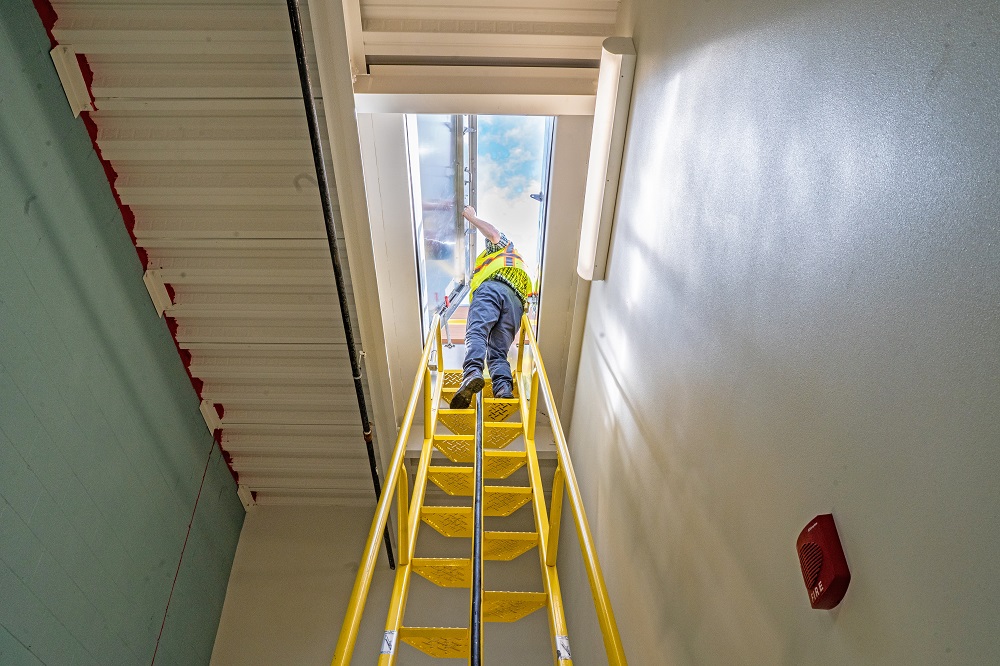Architects designing the new Adventist HealthCare White Oak Medical Center in Montgomery County, Maryland, faced a unique construction problem. They turned to The BILCO Company to help solve it.
The $400 million healthcare facility opened last August. The project included a central utility plant that houses mechanical equipment that sits near the hospital. But with space at a premium, the utility plant needed to be constructed within a tight and unusually-shaped geographic footprint. Large generators, boilers, water heaters and other mechanical equipment needed to be installed. They will also need to be replaced at some point in the future.
CallisonRTKL, the Maryland-based architect, designed a solution that allows equipment to be placed and removed through rooftop access. In addition to supplying standard roof hatches for ship stair access, BILCO manufactured four custom-made roof hatches, each 9-feet by 22-feet, to allow workers to access the equipment when they eventually need to be replaced.
“This is the largest roof hatch I’ve been associated with,’’ said Rick Brigham, who led the installation team for Cole Roofing. “The BILCO hatches were the best choice for this job due to their ability to custom fabricate them to meet special size requirements.”
Robb Macdonald of CBG South, the sales representative who recommended the hatches, said CallisonRTKL was impressed by BILCO’s ability to engineer and fabricate the hatches of such a large and unique size.
“They considered the life span expectations of the generators and looked for a way to replace them down the road,’’ Macdonald said. “The site’s slope presented a challenge to the traditional way of removing large equipment through the sides of the building, so rooftop access was the best solution.”
The 16,000 square foot utility plant includes four emergency generators, a cogeneration generator, four chillers, four boilers, 10 hot water heaters, electrical panels and switchgear and a small office for the building manager.
Central utility plants are frequently included in hospital construction. They are adaptable, expandable and allow easy access to replace aging equipment. “Locating all of the generators, chillers, electrical switchgear and hot water heaters separate from the hospital allows more future flexibility for the hospital and removes some of the more hazardous, mechanical, electrical and plumbing equipment from the hospital,’’ said Ryan Dellinger, architect for CallisonRTKL.
BILCO’s roof hatches are equipped with compression spring operators to provide smooth, one-hand operation regardless of size. They also include hold-open arms to lock the covers in the open position to ensure safe egress, and are constructed with corrosion-resistant materials.
 The roof hatches allow access so that the generators and other equipment can be removed. LNJ Designs Photo
The roof hatches allow access so that the generators and other equipment can be removed. LNJ Designs Photo
The hospital is a key part of an area that Montgomery County officials refer to as the “Science Gateway.” The area includes the new headquarters for the Food and Drug Administration, mixed-use projects, new public amenities, and the first rapid bus transit system in the state.
The hospital sits on a 48-acre parcel and the state-of-the-art facility includes 180 patient rooms. It replaces a facility that was more than a century old that was located six miles away.
(800) 366-6530
www.bilco.com
Commercial@bilco.com

Related Stories
| Aug 11, 2010
Suffolk Construction Company acquires William A. Berry & Son
Suffolk Construction Company, New England’s largest construction company announced today that they have acquired William A. Berry & Son (Berry), the second largest construction company in the region. The two companies, both with deep New England roots and successful track-records, combined will have more than 1,200 employees and projected revenues of $2 billion.
| Aug 11, 2010
Toronto mandates green roofs
The city of Toronto late last month passed a new green roof by-law that consists of a green roof construction standard and a mandatory requirement for green roofs on all classes of new buildings. The by-law requires up to 50% green roof coverage on multi-unit residential dwellings over six stories, schools, nonprofit housing, and commercial and industrial buildings.
| Aug 11, 2010
Great Solutions: Green Building
27. Next-Generation Green Roofs Sprout up in New York New York is not particularly known for its green roofs, but two recent projects may put the Big Apple on the map. In spring 2010, the Lincoln Center for the Performing Arts will debut one of the nation's first fully walkable green roofs. Located across from the Juilliard School in Lincoln Center's North Plaza, Illumination Lawn will consist ...
| Aug 11, 2010
Nurturing the Community
The best seat in the house at the new Seahawks Stadium in Seattle isn't on the 50-yard line. It's in the southeast corner, at the very top of the upper bowl. "From there you have a corner-to-corner view of the field and an inspiring grasp of the surrounding city," says Kelly Kerns, project leader with architect/engineer Ellerbe Becket, Kansas City, Mo.
| Aug 11, 2010
AIA Course: Enclosure strategies for better buildings
Sustainability and energy efficiency depend not only on the overall design but also on the building's enclosure system. Whether it's via better air-infiltration control, thermal insulation, and moisture control, or more advanced strategies such as active façades with automated shading and venting or novel enclosure types such as double walls, Building Teams are delivering more efficient, better performing, and healthier building enclosures.







